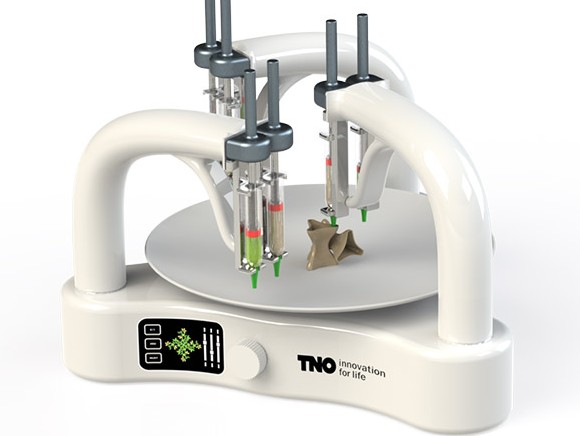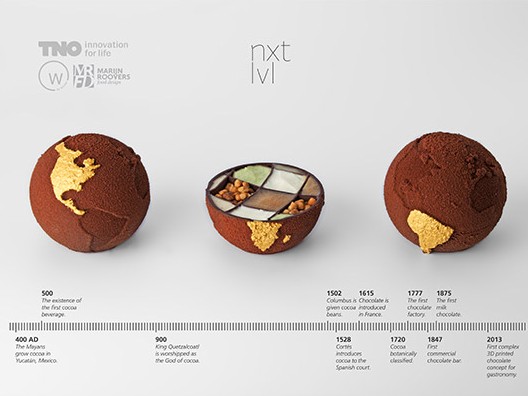
Nowadays, 3D printers can produce shapes using many different kinds of materials. From silver earrings to iPad covers, and from chocolate bars to toys printed from recycled plastic – the list of products that can be 3D printed is growing longer all the time. Food products are also increasingly making it onto that list.
'In search of the right structure, texture and taste experience'
On a rainy Friday afternoon, researchers at TNO Eindhoven pondered over an idea: if we can print a 3D shape from Nylon powder, could we do the same with chocolate powder? They immediately set to work on the idea. The euphoria following their first successful attempt created a bond between TNO’s technical department in Eindhoven and the food researchers in Zeist. How far has TNO come with the technology since then? What else is possible, apart from a concept conceived for fun on a Friday afternoon?
Jolanda Henket, researcher, and Daniël van der Linden, business developer Food & Nutrition, from TNO proudly show off a box containing a handful of food items that have been created/printed using the 3D technique: crazy cookies, perfect pasta shells, wacky wine gums. But why do/would we want to make food products using 3D printing? Daniël van der Linden summarises this context based on four key developments. “The first is the desire to personalize foods: in sport, healthcare for the elderly, children’s nutrition and also in hospitals. Therefore it is useful to be able to align food with people’s personal needs and health conditions. For example, in care homes a growing number of patients have trouble chewing and swallowing their food. They are served food in milkshake form, a pureed meal a couple of times a day. With 3D-printed food, we can put the enjoyment back into eating by aligning the chewability with a person’s capabilities and their nutritional needs/requirements. Apart from this, we also see opportunities to make use of alternative sources of protein such as algae, lupine seeds or insects. 3D printing enables us to create different textures and tastes with consumer appeal. Convenience plays a role too: products are supplied in edible format, and a printer is your ‘personal chef'. But right now, the fun factor and the freedom of design 3D printing offers seem to be attracting most attention in the market. Being able to give a product a totally different shape than normal adds considerable value to that product. 3D printing is still an expensive process at the moment, but the rapid pace of development will soon make it affordable and put it within reach – also for consumers,” he predicts.
“Although there are many different 3D methods, there are a number of basic techniques for printing products: FDM, SLS, SLA and PBP,” adds Jolanda. “These techniques are not specifically used for food; they apply to 3D printing in general. But all four of them have been tested on food products.” Daniël van der Linden: “Sometimes a preliminary step is required, such as grinding into a powder, mixing and blending. But ready-made powders often work just as well. The printing might be followed by a subsequent treatment such as cooking, baking or deep-frying, although that step isn’t always necessary: many products are ready to eat straight after printing.”
'3D-printed carrots, produced using FDM, for people who have trouble chewing and swallowing'
“FDM stands for Fused Deposition Modelling. With this technique a material is applied to a platform by a (micro)extruder,” explains Jolanda. “Through the focused movement of the extruder and the platform, the shape is created layer by layer. Some examples of printed food products include purees, jellies, doughs and melted substances such as chocolate. Recently, chocolate-based world globes have been produced using FDM. The surface of the Earth with all its continents and coastlines in fine detail are visible on the exterior. Inside the globes, the 3D technique was used to create compartments which were subsequently filled by hand.”
“PBP (Powder Bed Printing) has great potential to be used as a 3D food-printing technique,” believes Jolanda. “In PBP, powder is printed layer by layer in the desired shape, just as with SLS. But in contrast to SLS, PBP creates a 3D object by printing a liquid onto the powder bed in a shape that corresponds with the computer-generated layer of the 3D model.”
Jolanda: “The key research question at the moment is focused on ‘printability’: is it possible to maintain the desired shape during the entire printing process? It’s currently a matter of getting the balance right. If you make a change to one of the variables, it will impact all of the others too.”
“It’s still all about finding the ideal combination or balance between the printing process, ingredients/formulation and application/product,” agrees Daniël. “There are countless suitable ingredients, but they don’t all work with all techniques and for all applications. TNO has recently developed food formulas for a cookie which delivers good results in terms of shape. This basic formula can now be applied to other food products.”
“It’s a real challenge to optimise the process and get the conditions exactly right,” comments Jolanda enthusiastically. “It’s important to keep a close eye on parameters such as functional characteristics related to moisture retention and binding. We’re also currently exploring the possibilities for printing with the various macronutrients and how they behave in combination with other ingredients during the printing process. And of course we’re striving to create the right structure and texture, and – not insignificant in food products – the right taste experience.”

'Detailed 3D-printed chocolate globes for gastronomy'
“We know what is possible, and which steps must be taken next,” says Daniël van der Linden. “It’s now down to the industry, together with TNO, to invest in the further development of the techniques to enable individualised food products and textures. We are happy to assist companies in giving shape to their future with this turbulent development.”
Source: TNO